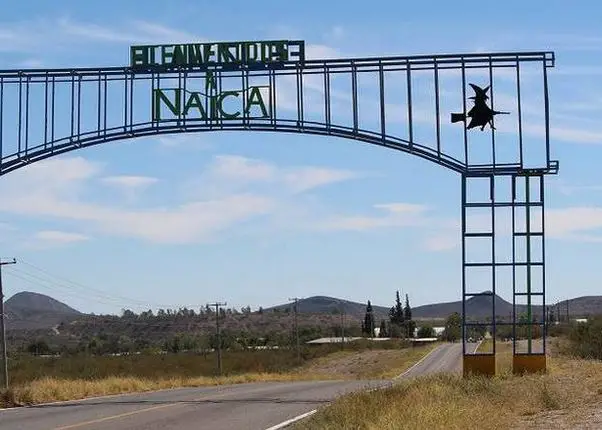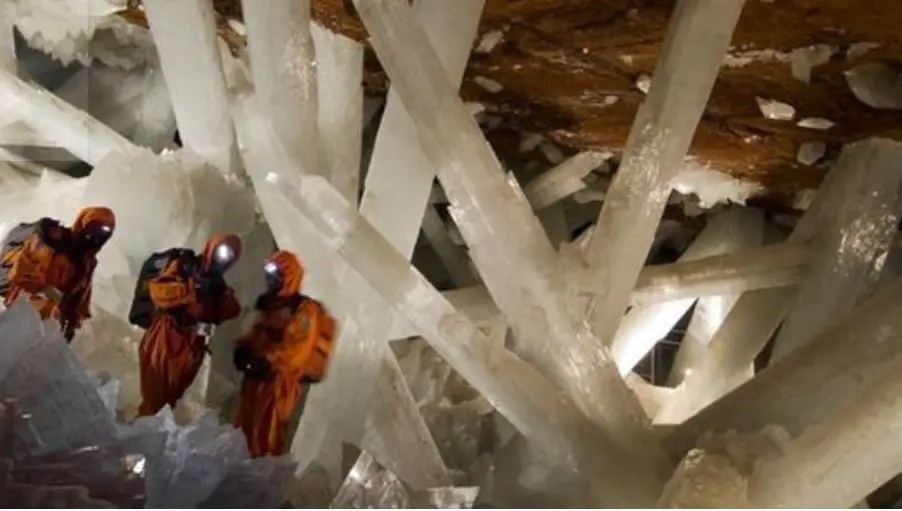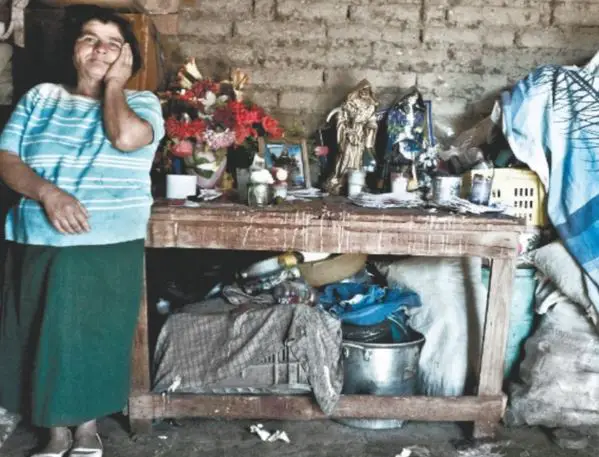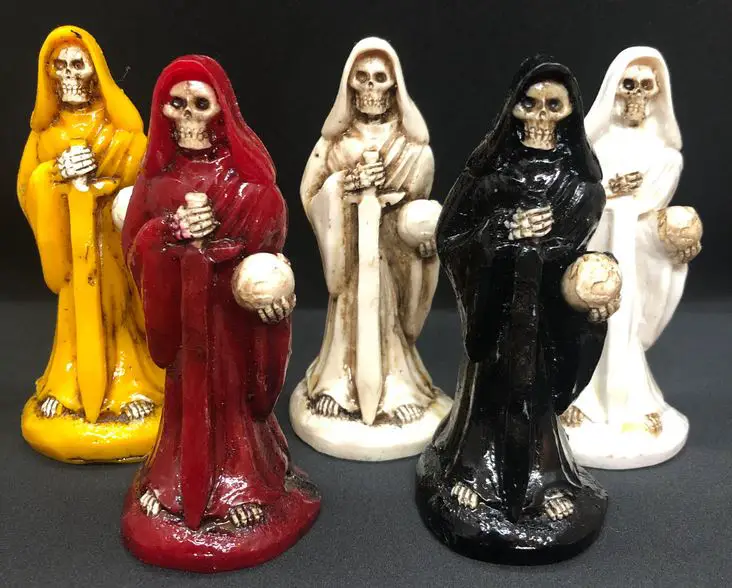Podcast: Play in new window | Download
Subscribe: Apple Podcasts | RSS
 In the year 2002 on the popular syndicated Latin American talk show “Cristina” the bleached blonde Cuban-born host Cristina Saralegui interviewed several people engaged in witchcraft and acts of sorcery. A member of her panel mentioned the town of Naica, Chihuahua, as being the witch capital of the world. The millions of viewers of “Cristina” became interested in this dusty desert mining town and after the show Naica was “on the map” regarding black magic, the occult and everything to do with sorcery and witchcraft. This town has a rival to its claim to fame, however, a much smaller town located some 400 miles away in the same north Mexican desert environment. The town of La Biznaga, Coahuila, also claims to be the chief town for witchcraft in Mexico. Here is the tale of these two towns.
In the year 2002 on the popular syndicated Latin American talk show “Cristina” the bleached blonde Cuban-born host Cristina Saralegui interviewed several people engaged in witchcraft and acts of sorcery. A member of her panel mentioned the town of Naica, Chihuahua, as being the witch capital of the world. The millions of viewers of “Cristina” became interested in this dusty desert mining town and after the show Naica was “on the map” regarding black magic, the occult and everything to do with sorcery and witchcraft. This town has a rival to its claim to fame, however, a much smaller town located some 400 miles away in the same north Mexican desert environment. The town of La Biznaga, Coahuila, also claims to be the chief town for witchcraft in Mexico. Here is the tale of these two towns.
Located about an hour and a half south southeast of the city of Chihuahua in the state of the same name, Naica was famous before being proclaimed “the world capital of witches” on the “Cristina” show. Outside of town is the famous Naica Mine where they routinely unearth large amounts of lead, zinc and silver. The biggest discovery connected with the Naica Mine was the Cueva de los Cristales, or in English, The Cave of Crystals where gigantic gypsum crystals have grown to over thirty feet long. The cave is below a similar cave discovered in 1910, La Cueva de las Espadas, or in English, The Cave of Swords, where there are crystals two to three feet long in the shape of swords. Because the Naica Mine sits above a magma dome, temperatures inside the caves can reach to over 130 degrees with almost 100% humidity. In the year 2015 the Cave of Crystals flooded and was closed off to researchers who were permitted to explore the caves before the flood only in special suits used to protect users from high temperatures in the caves. Since the major find of the cave with the gigantic crystals discovered in the year 2000, there have been other discoveries near the mine of similar caverns filled with crystal formations. These are the Queen’s Eye Cave, the Candles Cave and the Ice Palace. There is another curiously named cavern on local maps that ties into the whole witch theme of Naica. It is called La Cueva de las Brujas, or the Cave of the Witches. Because this cave is not so far underground there are no crystal formations in the shape of swords or anything else. According to some locals, the Cave of the Witches is where it all began many years ago, when local women began to practice “the black arts” under the cover of darkness in this cave. Some reported that women would enter the caves and hideous creatures would be seen flying out of them.
 The town does nothing to hide its reputation as a center for witchcraft. In fact, the steel archway over the road leading into town with the town’s name in its center has a silhouette of a witch on its righthand side. The black witch on the archway is sitting on a flying broomstick and is wearing a pointy top hat more reminiscent of a character from the American Halloween or folklore from the British Isles than anything Mexican. This welcoming witch was most likely placed here to attract tourists and to let visitors know that the town is welcoming of people engaging in “witch tourism.”
The town does nothing to hide its reputation as a center for witchcraft. In fact, the steel archway over the road leading into town with the town’s name in its center has a silhouette of a witch on its righthand side. The black witch on the archway is sitting on a flying broomstick and is wearing a pointy top hat more reminiscent of a character from the American Halloween or folklore from the British Isles than anything Mexican. This welcoming witch was most likely placed here to attract tourists and to let visitors know that the town is welcoming of people engaging in “witch tourism.”
The whole notion that witches inhabit the mining town of Naica may go back to simple cautionary tales told to children to scare them away from playing near the many abandoned mines in the area. For generations the children of Naica have heard about the witches that snatch children who get too close to their caves. In the stories, the whole idea of a “witch” in the form of a hideous female figure is also interchanged with red glowing orbs. These orbs have been seen around the abandoned mines by people who do not believe in or care about witchcraft. The “glowing orb” phenomenon is its own topic among paranormal and UFO researchers. Perhaps the cautionary stories told to children to keep them safe also include the glowing red orbs because many level-headed, non-superstitious people in the town have seen them and the danger is more believable when the orbs are involved in the stories. Some who wish to explain away the orbs call them a form of swamp gas that is formed deep in the humid, hot abandoned mines, exiting the mine shafts and coming up to the surface in the form of red balls of light. Many locals believe the orbs to be evil spirits or the work of Satan himself. These stories, whether cautionary or based on the presence of some sort of evil entity, were most certainly the foundation of Naica’s witch reputation, that seemed to take on a life of its own after the “Cristina” show.
A famous story, found on a Chihuahua tourism site run by the state government, tells of a 16-year-old girl who left her job at a Naica bakery after dark and walked to a small pond to admire the reflection of the moon on the water’s surface. When she did not return home, the town searched for her for months and she was never found. Years later, according to the story, she was seen by locals at the side of the pond, but old and haggard looking. Rumor had it that she had been taken by a group of witches that were looking to recruit teenage girls to expand the number in their coven.
Despite the town’s reputation, if there are witches in Naica, they are not very public, and the modern leaders of the town are not so enthusiastic to embrace its “witchiness” as those from 20 years ago. In April of 2022 the Chihuahua newspaper El Sol de Parral, interviewed Naica’s mayor Oscar Rea, who told the newspaper:
“I have lived here for 40 years, I was a farmer all my life and I lived near the cemetery, from where you can see the caves, they say that on certain dates the witches appear to do their spells and I have never seen one.”
 This statement made by Naica’s mayor is in stark contrast to what is happening over 400 miles away in the dusty town of La Biznaga, Coahuila. The witches there are out in the open and have been for decades. Some of them, like Martha Molina, have become stars on YouTube and TikTok taking witchcraft into the 21st Century and appealing to the younger generations.
This statement made by Naica’s mayor is in stark contrast to what is happening over 400 miles away in the dusty town of La Biznaga, Coahuila. The witches there are out in the open and have been for decades. Some of them, like Martha Molina, have become stars on YouTube and TikTok taking witchcraft into the 21st Century and appealing to the younger generations.
While in a similar desert environment, there are a few notable differences between La Biznaga and Naica. For one, La Biznaga has a fraction of the population of Naica. The 2020 census shows La Biznaga as having only 444 people. The notoriety of the witches in the area goes back centuries, some say even into indigenous times, instead of being a recent phenomenon. As mentioned earlier, the witches here are out in the open, and have been more open about their practices, and their services offered, in just the past few years. Although La Biznaga has always been known as a “witch town,” if outsiders came to town looking for a witch to cast a spell or remove a curse, they would have had to have gained the confidence of the locals in order to get a referral. Now, services are offered much as one would go to a doctor’s office for a consultation. La Biznaga has been known as a regional center for healing, as part of the “white witchcraft” that has been practiced here for many years. The town’s many practicing “white witches” could be compared to traditional curanderas or folk healers found throughout Mexico and the southwestern United States, using herbal medicine along with spells, chants and other rituals, mixed with local indigenous healing wisdom.
In the 1960s the town of La Biznaga saw a battle between the “dark” and the “light” forces of witchcraft that has carried over into the early part of the 21st Century. Many people in the town were caught in this supernatural crossfire and suffered as a result of this bizarre turf war. Townsfolk who chose sides found themselves on the receiving end of curses and were plagued with misfortune in the areas of health, love and finances. The town’s cemetery became a battleground for the witches, the graveyard’s surface covered in amulets and other artifacts of the trade used to curse and counter-curse, to cast spells and to untangle spells. Unlike Naica, La Biznaga has done nothing to promote itself as a center for witchcraft and does not actively court tourists.
 La Biznaga’s most famous witch, Martha Molina, is one of the only ones in the town willing to grant interviews. Many journalists from around Mexico have interviewed her in front of her home altar, full of statues of the Santa Muerte, beneath a few strings of blinking Christmas lights. Martha says flat out that she is a “bruja negra,” or “black witch,” skilled in the dark arts. The diminutive lady says that the so-called “white magic” doesn’t work and what she does always has powerful and immediate results. She claims that this powerful magic she uses is 100% for healing and for solving problems and that she doesn’t engage in curses. Martha works alone and uses various traditional herbs in her physical healings. Other issues require other remedies, including prayers and rituals to saints and spirits. Her most often used saint is the Santa Muerte, followed by Saint Jude and what Mexicans call San Martín Caballero, who is Saint Martin of Tours mounted on a horse. Her Santa Muerte statues on her healing altar come in different colors: red for luck, black for medical issues and silver for everything else. She even has a Santa Muerte painted in all three colors. For more information about this Mexican folk saint please see Mexico Unexplained episode number 9: https://mexicounexplained.com/the-santa-muerte-death-respected/ Martha says that when she was born, her paternal grandmother took one look at her and proclaimed that she was ugly and wouldn’t amount to anything. Her mother said that she would be a great healer, and when she was a little girl, she cured her first person at the age of 9. That person was her own brother who fell down a chimney and was not expected to live. Is Martha afraid that all of her “dark magic” will come back to affect her in a bad way? She sits in her home reassured that she has adequate spiritual protection and that because she is the most powerful witch in La Biznaga that she has not succumbed to any rival witch’s curse or evil spell. Unlike other practitioners in the town, she keeps to herself and concentrates on her own work. Perhaps the other witches in La Biznaga and everyone else for that matter, can learn something from this.
La Biznaga’s most famous witch, Martha Molina, is one of the only ones in the town willing to grant interviews. Many journalists from around Mexico have interviewed her in front of her home altar, full of statues of the Santa Muerte, beneath a few strings of blinking Christmas lights. Martha says flat out that she is a “bruja negra,” or “black witch,” skilled in the dark arts. The diminutive lady says that the so-called “white magic” doesn’t work and what she does always has powerful and immediate results. She claims that this powerful magic she uses is 100% for healing and for solving problems and that she doesn’t engage in curses. Martha works alone and uses various traditional herbs in her physical healings. Other issues require other remedies, including prayers and rituals to saints and spirits. Her most often used saint is the Santa Muerte, followed by Saint Jude and what Mexicans call San Martín Caballero, who is Saint Martin of Tours mounted on a horse. Her Santa Muerte statues on her healing altar come in different colors: red for luck, black for medical issues and silver for everything else. She even has a Santa Muerte painted in all three colors. For more information about this Mexican folk saint please see Mexico Unexplained episode number 9: https://mexicounexplained.com/the-santa-muerte-death-respected/ Martha says that when she was born, her paternal grandmother took one look at her and proclaimed that she was ugly and wouldn’t amount to anything. Her mother said that she would be a great healer, and when she was a little girl, she cured her first person at the age of 9. That person was her own brother who fell down a chimney and was not expected to live. Is Martha afraid that all of her “dark magic” will come back to affect her in a bad way? She sits in her home reassured that she has adequate spiritual protection and that because she is the most powerful witch in La Biznaga that she has not succumbed to any rival witch’s curse or evil spell. Unlike other practitioners in the town, she keeps to herself and concentrates on her own work. Perhaps the other witches in La Biznaga and everyone else for that matter, can learn something from this.
REFERENCES
Ayala, Rodrigo. “¿Por qué este pequeño poblado en Chihuahua es considerado la capital mundial de las brujas?” In Muy Interesante, 2 May 2022. (in Spanish)
Escobar, Fernando. “Las brujas del ejido La Biznaga.” In El Sol de la Laguna, 27 Jul 2022. (in Spanish)
Sinaloa, Samuel. “¿Naica, la capital de las brujas? In El Sol de Parral, 18 Apr 2022. (in Spanish)
